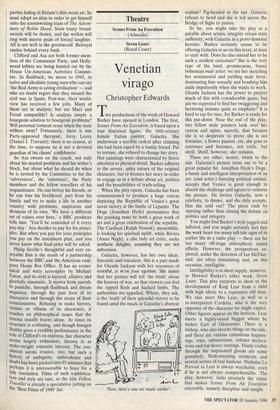Theatre
Scenes From An Execution (Almeida)
Seven Lears (Royal Court)
Venetian virago
Christopher Edwards
Two productions of the work of Howard Barker have opened in London. The first, Scenes From An Execution, is based upon a true historical figure, the 16th-century female Italian painter, Galactia. She underwent a terrible ordeal after claiming she had been raped by a family friend. Put to torture, she refused to change her story. Her paintings were characterised by fierce attention to physical detail. Barker adheres to the severe, spiky nature of the original character, but re-focuses her story in order to engage us in a debate about art, politics and the 'possibilities of truth-telling.
When the play opens, Galactia has been commissioned to produce a huge canvas depicting the Republic of Venice's great naval victory at the battle of Lepanto. The Doge (Jonathan Hyde) pronounces that the painting must be both a great work of art and a great celebration of the republic. The Cardinal (Ralph Nossek), meanwhile, is looking for spiritual uplift, while Rivera (Anna Nygh), a chic lady art critic, seeks aesthetic delights, assuming they are not subversive.
Galactia, however, has her own ideas. Sarcastic and truculent, this is a part made for Glenda Jackson with her resources of scornful, je m'en foue egotism. She insists that her picture will tell 'the truth' about the horrors of war, so that viewers can feel the ripped flesh and hacked limbs. The authorities are appalled. Where, they ask, is the 'truth' of their splendid victory to be found amid the muck of Galactia's abattoir 'Now, here's one we made earlier'. realism? Pig-headed to the last, Galactia refuses to bend and she is led across the Bridge of Sighs to prison.
So far, you might take the play as a parable about artistic integrity versus state authority, with Galactia as a proto-feminist heroine. Barker certainly seems to be offering Galactia to us on this level, at least to start with. Does he also intend her to be such a strident caricature? She is the very type of the hard, promiscuous, boozy bohemian male artist: we see her sketching her sentimental and yielding male lover, dominating him sexually and brushing him aside impatiently when she wants to work. Glenda Jackson has the power to project much of this with considerable gusto, but are we supposed to find her swaggering and hectoring manner quite so emphatic? It is hard to say for sure, for Barker is ready for this put-down. Near the end of the play, two fellow male painters look over her canvas and opine, suavely, that because she is so desperate to prove she is not feminine, a flower painter, etc, she goes to extremes and becomes, not virile, but shrill. Shrill, however, she remains.
There are other, neater, twists to the tale. Galactia's picture turns out to be a great popular hit. Jonathan Hyde's Doge, a funny and intelligent interpretation of an art- (and artist-) fancying political animal, accepts that Venice is great though to absorb the challenge and agrees to endorse the picture. He invites Galactia, now a celebrity, to dinner, and she slyly accepts. Has she sold out? The piece ends by opening rather than closing the debate on politics and integrity.
You might find Barker's style jagged and inflated, and you might certainly feel that the work bears too many tell-tale signs of its earlier life as a radio play — there are far too many off-stage atmospheric sound effects. However, the perspectives ex- plored, under the direction of Ian McDiar- mid, are often stimulating and, on this occasion, intelligible.
Intelligibility is in short supply, however, in Howard Barker's other work, Seven Lears. This play purports to show us the development of King Lear from a child with high ideals to a repressive old man. We also meet Mrs Lear, as well as a re-interpreted Cordelia, who is the very opposite of the character we might expect. Other figures appear on the horizon. Lear meets a highly-sexed beggar whom he makes Earl of Gloucester. There is a bishop, who also invents things on the side, and there are various calamitous happen- ings, cries, submersions, solemn declara- tions and top-heavy rantings. Dimly visible through the inspissated gloom are some genuinely, flesh-creeping moments and several scenes of real humour. Nicholas Le Prevost as Lear is always watchable, even if he is not always comprehensible. The play, however, lacks precisely the virtue that makes Scenes From An Execution enjoyable, namely discipline and insight.


















































 Previous page
Previous page